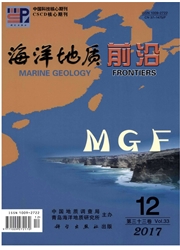

 中文摘要:
中文摘要:
西地中海加的斯湾、埃布罗湾、巴塞罗那岸外和利翁湾等外陆架和陆坡上部分布大片的砂质水下沙丘、沙带、沙脊以及沙席等砂质底形。沙丘长为150~760m,最长为3km;高一般为0.1~5.0m,最高为20m。背流坡指向SW,丘长与丘高相关斜率为H=0.934L0.006 3,低于1978年世界标准的F氏斜率线;沙脊长为4~24km,宽为1~2.3km,高出海底10~30m。砂层厚约12~30m,其成因与冰消期古岸线相关。以水深350m的直布罗陀海峡为中心,大西洋低盐水团和地中海高盐水团相交换而形成的地中海环流是导致海底砂质底形发育的主要动力,陆架外侧普遍分布的垂岸沟谷及顺谷流也起一定作用。据14C年代测定,大型沙丘沙脊形成于距今13~11ka的冰消期,当时海面波动式趋稳。现代洋流只能在暴风浪期间、底流速较大时才能带动泥沙运动且进行局部修饰、破坏和蚀低原砂质底形。
 英文摘要:
英文摘要:
There lie many sand dunes, sand ribbons, sand ridges and sand sheets on the outer conti- nental shelf and slope of the Gulf of Cadiz, Ebro Bay, Barcelona coast and the Gulf of Lion of western Mediterranean. The dune wavelength ranges from 150 to 760 m, whereas the height ranges from 0.1 to 5 m. The longest dune reaches 3 km, of which the highest is up to 20 m. The downstream slope dips to SW, and the height is H=0. 934L^0.0063, which is lower than the Flemming slope, the global standard in 1978. About 10 to 30 m high from the seafloor, the sand ridge has its length ranging from 4 to 24 km and the width is from 1 to 2.3 kin. The thickness of sand sheet is from 12 to 30 m and its formation is related to Deglacial paleoshoreline. Regarding the Strait of Gibraltar with a depth of 350m in the center, the Mediterranean circula- tion generated by the exchange of the Atlantic low-salt water mass and the Mediterranean high-salt water mass is the main force for the development of the submarine sandy bed. The cross-shore ravines and the currents along them, which are widely distributed off the coast, have also plaed a role on its formation. ^14C dating indicates that the large dunes and ridges were formed during the period of Deglaciation from 11ka to 13 ka BP, when surface wave tended to stabilize. Only during the period of storm wave, while the bottom flow velocity is relatively high, the modern oceanic current can drive the sediment to move and partially destroy the original sandy bedforms.
 同期刊论文项目
同期刊论文项目
 同项目期刊论文
同项目期刊论文
 期刊信息
期刊信息
